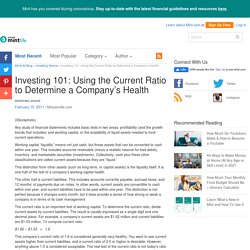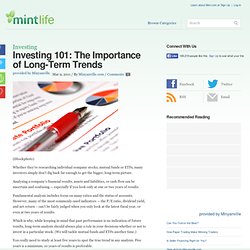

Tools for Analysis and Valuation. Blogs, Message Boards. Mint. The appeal of Exchange Traded Funds (ETFs, for short) is simple: They trade like stocks, but contain a basket of assets, much like a mutual fund.

This provides instant diversification, without the need to research every last stock or bond. For example, an S&P 500 ETF covers all (or most) of the stocks on the... Read more According to the Bureau of Economic Analysis, the average American spends over $1400 on buying clothes and related items per year and it’s been estimated that most people only wear 20% of the clothing they own.
Want to look great, keep the closet clutter to the minimum, and stop wasting money on unworn items? Whether you’re religious or not, Easter can be an incredibly fun time of year — delicious candy, beautiful eggs, fluffy bunnies, and pastel everything. Zillow real estate investment writer and long-term investor Leonard Baron, MBA, is answering questions from MintLife readers.
Filling up your child’s Easter basket can be an expensive endeavor. Inflation. Current Ratio. (iStockphoto) Any study of financial statements includes basic tests in two areas: profitability (and the growth trends that includes) and working capital, or the availability of liquid assets needed to fund current operations.

Working capital “liquidity” means not just cash, but those assets that can be converted to cash within one year. This includes accounts receivable (minus a realistic reserve for bad debts), inventory, and marketable securities (investments). Collectively, cash plus these other classifications are called current assets because they are “liquid.” This distinction from other assets (such as long-term, or capital assets) is the liquidity itself. The other half is current liabilities. The current ratio is an important test of working capital.
This company’s current ratio of 1.6 is considered generally very healthy. Be cautious, though. Checking working capital demands not only a check of the current year, but also of the long-term trend. Michael C. Long-term Trends. (iStockphoto) Whether they’re researching individual company stocks, mutual funds or ETFs, many investors simply don’t dig back far enough to get the bigger, long-term picture.

Analyzing a company’s financial results, assets and liabilities, or cash flow can be uncertain and confusing — especially if you look only at one or two years of results. Fundamental analysis includes focus on many ratios and the status of accounts. However, many of the most commonly-used indicators — the P/E ratio, dividend yield, and net return – can’t be fairly judged when you only look at the latest fiscal year, or even at two years of results.
Which is why, while keeping in mind that past performance is no indication of future results, long-term analysis should always play a role in your decisions whether or not to invest in a particular stock. You really need to study at least five years to spot the true trend in any analysis. So where do you get all the information you need? 1. 2. 3. The Bottom Line.
Commodities.